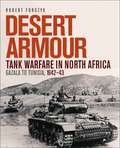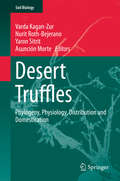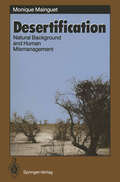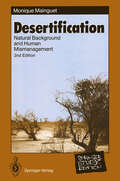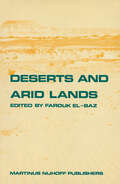- Table View
- List View
Desert Armour: Tank Warfare in North Africa: Gazala to Tunisia, 1942–43
by Robert ForczykRobert Forczyk covers the development of armoured warfare in North Africa from Rommel's Gazala offensive in 1942 through to the end of war in the desert in Tunisia in 1943. The war in the North African desert was pure mechanized warfare, and in many respects the most technologically advanced theatre of World War II. It was also the only theatre where for three years British and Commonwealth, and later US, troops were in constant contact with Axis forces.World War II best-selling author Robert Forczyk explores the second half of the history of the campaign, from the Gazala offensive in May 1942 that drove the British forces all the way back to the Egyptian frontier and led to the fall of Tobruk, through the pivotal battles of El Alamein, and the final Allied victory in Tunisia. He examines the armoured forces, equipment, doctrine, training, logistics and operations employed by both Allied and Axis forces throughout the period, focusing especially on the brigade and regimental level of operations.Fully illustrated throughout with photographs, profile artwork and maps, and featuring tactical-level vignettes and appendices analysing tank data, tank deliveries in-theatre and orders of battle, this book goes back to the sources to provide a new study of armoured warfare in the desert.
Desert Armour: Tank Warfare in North Africa: Gazala to Tunisia, 1942–43
by Robert ForczykRobert Forczyk covers the development of armoured warfare in North Africa from Rommel's Gazala offensive in 1942 through to the end of war in the desert in Tunisia in 1943. The war in the North African desert was pure mechanized warfare, and in many respects the most technologically advanced theatre of World War II. It was also the only theatre where for three years British and Commonwealth, and later US, troops were in constant contact with Axis forces.World War II best-selling author Robert Forczyk explores the second half of the history of the campaign, from the Gazala offensive in May 1942 that drove the British forces all the way back to the Egyptian frontier and led to the fall of Tobruk, through the pivotal battles of El Alamein, and the final Allied victory in Tunisia. He examines the armoured forces, equipment, doctrine, training, logistics and operations employed by both Allied and Axis forces throughout the period, focusing especially on the brigade and regimental level of operations.Fully illustrated throughout with photographs, profile artwork and maps, and featuring tactical-level vignettes and appendices analysing tank data, tank deliveries in-theatre and orders of battle, this book goes back to the sources to provide a new study of armoured warfare in the desert.
Desert Edens: Colonial Climate Engineering in the Age of Anxiety (Histories of Economic Life #9)
by Philipp LehmannHow technological advances and colonial fears inspired utopian geoengineering projects during the late nineteenth and early twentieth centuries From the 1870s to the mid-twentieth century, European explorers, climatologists, colonial officials, and planners were avidly interested in large-scale projects that might actively alter the climate. Uncovering this history, Desert Edens looks at how arid environments and an increasing anxiety about climate in the colonial world shaped this upsurge in ideas about climate engineering. From notions about the transformation of deserts into forests to Nazi plans to influence the climates of war-torn areas, Philipp Lehmann puts the early climate change debate in its environmental, intellectual, and political context, and considers the ways this legacy reverberates in the present climate crisis.Lehmann examines some of the most ambitious climate-engineering projects to emerge in the late nineteenth and early twentieth centuries. Confronted with the Sahara in the 1870s, the French developed concepts for a flooding project that would lead to the creation of a man-made Sahara Sea. In the 1920s, German architect Herman Sörgel proposed damming the Mediterranean in order to geoengineer an Afro-European continent called &“Atlantropa,&” which would fit the needs of European settlers. Nazi designs were formulated to counteract the desertification of Eastern Europe and Central Asia. Despite ideological and technical differences, these projects all incorporated and developed climate change theories and vocabulary. They also combined expressions of an extreme environmental pessimism with a powerful technological optimism that continue to shape the contemporary moment.Focusing on the intellectual roots, intended effects, and impact of early measures to modify the climate, Desert Edens investigates how the technological imagination can be inspired by pressing fears about the environment and civilization.
Desert Energy: A Guide to the Technology, Impacts and Opportunities
by Alasdair CameronFirst published in 2013. Routledge is an imprint of Taylor & Francis, an informa company.
Desert Energy: A Guide to the Technology, Impacts and Opportunities
by Alasdair CameronFirst published in 2013. Routledge is an imprint of Taylor & Francis, an informa company.
Desert Plants: Biology and Biotechnology
by K. G. RamawatDeserts appear very fascinating during our short visits. However, the lives of plants and animals are very dif?cult under the harsh climatic conditions of high tempe- ture and scant water supply in deserts, sometimes associated with high concent- tions of salt. The editor of this book was born and brought up in the Great Indian Desert, and has spent much of his life studying the growth and metabolism of desert plants. It is very charming on a cool summer evening to sit at the top of a sand dune listening only to blowing air and nothing else. It has been my dream to prepare a volume on desert plants encompassing various aspects of desert plant biology. In this book, I have tried to present functional and useful aspects of the vegetation resources of deserts along with scienti?c input aimed at understanding and impr- ing the utility of these plants. The scant vegetation of deserts supports animal life and provides many useful medicines, timber and fuel wood for humans. Therefore, there are chapters devoted to medicinal plants (Chap. 1), halophytes (Chaps. 13, 14), and fruit plants (Chaps. 17, 20). Desert plants have a unique reproductive biology (Chaps. 9–11), well-adapted eco-physiological and anatomical charact- istics (Chap. 7), and specialised metabolism and survival abilities. These plants are dif?cult to propagate and pose many problems to researchers developing biote- nological approaches for their amelioration (Chaps. 18–20).
Desert Truffles: Phylogeny, Physiology, Distribution and Domestication (Soil Biology #38)
by Varda Kagan-Zur Nurit Roth-Bejerano Yaron Sitrit Asunción MorteDesert truffles are found in every known desert, irrespective of the habitat – cool or hot, loamy or acidic, sandy or heavy soil – the only common condition seems to be a limited supply of water. In contrast to ‘true’ truffles, desert truffles have evolved over time in different families, mainly within the order Pezizales. While in some arid areas, desert truffles have been traditionally used as food, in most regions interest has only recently been increasing, and truffles are now treasured for their nutritional value, as an income source and for research.This volume gives a comprehensive overview of the phylogeny, biology, mycorrhizal association, and distribution of desert truffles, their use, biochemical and medicinal properties, as well as their domestication and cultivation.
Desert Weeds: Personal Narrative on Botanical First Responders
by Garry RogersIn their rapid colonization of soil exposed by fires, floods, and grazing animals, weeds resemble the human specialists we label Emergency Medical Technicians (EMTs). Weeds are the first responders when disasters occur in nature. They occupy bare soil and prevent erosion by wind and water. In extreme cases such as a landslide, weeds are essential to the healing processes that replace the lost soil. Like a Band-Aid on a skinned knee, weeds protect the land while it recovers. Besides protecting the soil after disaster, weeds provide food for wildlife, and some of them provide food and medicine for people. Able to withstand harsh conditions, weeds will proliferate as global warming and other human impacts intensify. Thus, nature’s EMTs will increase while all other plants decline. The book provides a succinct definition of weeds according to their form and function in ecosystem processes. The narrative uses a representative set of weed species from a desert location to illustrate the full range of weed characteristics.
Desertification: Natural Background and Human Mismanagement (Springer Series in Physical Environment #9)
by Monique MainguetControversial, and often discussed with passion and vehemence, desertification is a problem on whose solution the survival of millions of humans is dependent. This book aims at an understanding of what is commonly called "desertification" - a term which has a connotation of irreversibility, spreading and emergence of desert-like landscapes: "land degradation" is proposed to replace it. The purpose is to present what has happened in reality, and what might be done. Illustrative worldwide analyses allow a more realistic evaluation of global land degradation. Each level of technology, excessive or insufficient, creates its own mismanagement. This is reflected in a decrease in soil productivity and eventually land degradation. The benefit to the reader is an awareness of the ecozones which have undergone the most severe land degradation, and a global overview of the phenomena, mechanisms and existing solutions.
Desertification: Natural Background and Human Mismanagement (Springer Study Edition)
by Monique MainguetAfter UNCED (United Conference on Environment and Development, Rio de Janeiro, July 1992), a second edition of Desertification was necessary. About 150 corrections, amendments and additions take scientific progress into account. The author also presents an updated chapter in which the results of UNCED are analyzed. This book aims at an understanding of what is commonly called "desertification" - a term which is proposed to be replaced by "land degradation". Each level of technology, excessive or insufficient, creates its own mismanagement. This is reflected in an increase in land degradation and eventually a decrease in soil productivity. The benefit to the reader is an awareness of the ecozones and a global overview of the phenomena, mechanisms and existing solutions.
Desertification and Its Control in China
by Longjun Ci Xiaohui Yang"Desertification and Its Control in China" comprehensively discusses desertification from the views of formation, distribution, development and control models. This book truly elucidates basic theory and control models of desertification, especially the numerous results from research carried out for the UN Convention to Combat Desertification. This book will provide a theoretical and practical basis for ecological and environmental planning and design as well as guidelines for prevention/restoration for desertification projects. It will also provide practical examples. Dr. Longjun Ci earned her degree at Cornell University; she is a lead research scientist at the Chinese Academy of Forestry. Dr. Xiaohui Yang earned his degree at Beijing Forestry University; he is an Associate Professor at the Research Institute of Forestry, Chinese Academy of Forestry.
Desertification and Land Degradation: Concept to Combating
by Ajai Rimjhim BhatnagarDesertification and land degradation are complex phenomena, and we need to understand their causes, consequences, and means to mitigate and combat their impact. Therefore, this book aims to explain the concept and characteristics of drylands, desert and desertification, land degradation, wastelands, and the concept of ecosystem services. It also discusses various types of processes of land degradations, their characteristics, physics and indicators along with mapping, monitoring and assessment of methods involved. Concept of Ocean Biological Deserts is discussed along with international and regional efforts towards combating land degradation and desertification. Key Features:• Provides all the aspect of desertification and land degradation at one place • Includes comprehensive methods to monitor different desertification/land degradation processes • Comprehensive overview of the mapping, monitoring and modelling techniques • Role of space borne data in identifying, monitoring and combating desertification is evaluated and reported with real case studies • Explains the concept of ocean biological deserts, their characteristics and mapping
Desertification and Land Degradation: Concept to Combating
by Ajai Rimjhim BhatnagarDesertification and land degradation are complex phenomena, and we need to understand their causes, consequences, and means to mitigate and combat their impact. Therefore, this book aims to explain the concept and characteristics of drylands, desert and desertification, land degradation, wastelands, and the concept of ecosystem services. It also discusses various types of processes of land degradations, their characteristics, physics and indicators along with mapping, monitoring and assessment of methods involved. Concept of Ocean Biological Deserts is discussed along with international and regional efforts towards combating land degradation and desertification. Key Features:• Provides all the aspect of desertification and land degradation at one place • Includes comprehensive methods to monitor different desertification/land degradation processes • Comprehensive overview of the mapping, monitoring and modelling techniques • Role of space borne data in identifying, monitoring and combating desertification is evaluated and reported with real case studies • Explains the concept of ocean biological deserts, their characteristics and mapping
Desertification and Risk Analysis Using High and Medium Resolution Satellite Data: Training Workshop on Mapping Desertification (NATO Science for Peace and Security Series C: Environmental Security)
by Alberto Marini Mohamed TalbiThis work becomes with methodological rigor a part of the innovative proposals for the characterization of the areas at risk of desertification. The complexity of the phenomenon of desertification, which involves extended surfaces in all continents, is one of the most alarming processes of the environmental degradation of our Planet and threatens the health and the living conditions of over a billion of persons. The food crisis, in continuous increase, ask for the world of research to urgently supply reassuring solutions concerning the acquisition of indicators, which are easy to monitor and concur to control the phenomenon in order to fight its acceleration. The constant but different combination that determines the diffusion of deserti- cation in the territories, attributable mostly to climatic changes and the activities of the man, makes our job challenging and complicated, since it varies from region to region. We are aware of all this and therefore we think that the methodological approach of survey of the data is an extremely important element to locate of the phenomenon and to monitor its course. This work, which is characterized for its multi-disciplinary approach, suggests solutions that we wish will quickly find concrete applications at international level. Prof. Bruno Dettori President CNLSD (Comitato Nazionale per la Lotta alla Siccità e alla Desertificazione) v
Desertification in Developed Countries: International Symposium and Workshop on Desertification in Developed Countries: Why can’t We Control It?
by Charles F. Hutchinson David A. MouatDesertification has re-emerged as a topic of global significance as a consequence of the United Nations Conference on Environment and Development. When first addressed over a generation ago, attention was drawn to the compelling, spectacular images of sand dunes engulfing farmlands and parched cattle dying around wells. Research tended to focus on these events as unusual phenomena that involved the unfortunate collision of climate and `irrational' land use. Since then, the work of many researchers has shown us that desertification is a multifaceted problem that involves climatic, biogeochemical, political, and socio-economic processes that operate more or less continuously but at rates that vary in time and space. No attempts to arrest or reverse desertification that ignore this complexity are likely to succeed. In a single volume, `Desertification in Developed Countries' describes the multiple dimensions of desertification as well as the novel approaches that have been used to address it within the economies of developed countries. This is done from the perspectives and experiences of the numerous authors who have contributed to this book.
Desertification in the Mediterranean Region. A Security Issue: Proceedings of the NATO Mediterranean Dialogue Workshop, held in Valencia, Spain, 2-5 December 2003 (pdf) (Nato Security through Science Series C: #Vol. 3)
by David A. Mouat Fausto Pedrazzini Jose L. Rubio W. G. KepnerDeserts and arid lands (Remote Sensing of Earth Resources and Environment #1)
by FaroukEl-BazRemote sensing is the study of a region from a distance, particularly from an airplane or a spacecraft. It is a tool that can be used in conjunction with other methods of research and investigation. This tool is especially applicable to the study of the deserts and arid lands of the Earth because of their immense size and their inaccessibility to detailed study by conventional means. In this book examples are given of the utility of aerial photographs and space images in the study of semi-arid, arid, and hyper-arid terrains. Emphasis is placed on the physical features and terrain types using examples from around the world. The authors I have called upon to prepare each chapter are renowned specialists whose contributions have received international recognition. To the general reader, this book is a review of our knowledge of the relatively dry parts of the Earth, their classification and varied features, their evolution in space and time, and their development potentials. To the specialist, it is a detailed account of the deserts and arid lands, not only in North America, but also their relatively unknown counterparts in North Africa, Australia, China, India, and Arabia.
Desiccant-Assisted Cooling: Fundamentals and Applications
by Carlos Eduardo Leme Nóbrega Nisio Carvalho Lobo BrumThe increasing concern with indoor air quality has led to air-quality standards with increased ventilation rates. Although increasing the volume flow rate of outside air is advisable from the perspective of air-quality, it is detrimental to energy consumption, since the outside air has to be brought to the comfort condition before it is insufflated to the conditioned ambient. Moreover, the humidity load carried within outside air has challenging HVAC engineers to design cooling units which are able to satisfactorily handle both sensible and latent contributions to the thermal load. This constitutes a favorable scenario for the use of solid desiccants to assist the cooling units. In fact, desiccant wheels have been increasingly applied by HVAC designers, allowing distinct processes for the air cooling and dehumidification. In fact, the ability of solid desiccants in moisture removal is effective enough to allow the use of evaporative coolers, in opposition to the traditional vapor-compression cycle, resulting in an ecologically sound system which uses only water as the refrigerant.Desiccant Assisted Cooling: Fundamentals and Applications presents different approaches to the mathematical modeling and simulation of desiccant wheels, as well as applications in thermal comfort and humidity controlled environments. Experts in the field discuss topics from enthalpy, lumped models for heat and mass transfer, and desiccant assisted radiant cooling systems, among others.Aimed at air-conditioning engineers and thermal engineering researchers, this book can also be used by graduate level students and lecturers in the field.
Desiccant Heating, Ventilating, and Air-Conditioning Systems
by Napoleon Enteria Hazim Awbi Hiroshi YoshinoThis book presents the necessary fundamental knowledge in the research, development, design, selection, and application of desiccant heating, ventilating, and air-conditioning systems. It covers the established installations in different climatic conditions and building types. In addition, advanced performance evaluation techniques are presented, covering thermodynamic, economic, and environmental aspects. Hence, the book is an important resource for undergraduate and graduate students, design and installation engineers, researchers and scientists, building owners and occupants, and energy and environmental policy makers.
DESider – A European Effort on Hybrid RANS-LES Modelling: Results of the European-Union Funded Project, 2004 - 2007 (Notes on Numerical Fluid Mechanics and Multidisciplinary Design #103)
by Werner Haase Marianna Braza Alistair RevellPreface “In aircraft design, efficiency is determined by the ability to accurately and rel- bly predict the occurrence of, and to model the development of, turbulent flows. Hence, the main objective in industrial computational fluid dynamics (CFD) is to increase the capabilities for an improved predictive accuracy for both complex flows and complex geometries”. This text part taken from Haase et al (2006), - scribing the results of the DESider predecessor project “FLOMANIA” is still - and will be in future valid. With an ever-increasing demand for faster, more reliable and cleaner aircraft, flight envelopes are necessarily shifted into areas of the flow regimes exhibiting highly unsteady and, for military aircraft, unstable flow behaviour. This undou- edly poses major new challenges in CFD; generally stated as an increased pred- tive accuracy whist retaining “affordable” computation times. Together with highly resolved meshes employing millions of nodes, numerical methods must have the inherent capability to predict unsteady flows. Although at present, (U)RANS methods are likely to remain as the workhorses in industry, the DESider project focussed on the development and combination of these approaches with LES methods in order to “bridge” the gap between the much more expensive (due to high Reynolds numbers in flight), but more accurate (full) LES.
Design Acoustics: Primary and Secondary Noise Mitigation
by Gh. Reza SinambariThis technical book focuses on the acoustic analysis of weak points in a comprehensible manner. This reliably helps the designer and acoustician to understand the noise development of machines and systems and to develop suitable primary and secondary noise reduction measures. Selected application examples from practice support the user in developing his own ideas for the implementation of product-related noise reductions.
Design Added Value: How Design Increases Value for Architects and Engineers
by Ömer AkınDesign has intrinsic, economic value. To make this value tangible, design features of buildings need to be explored, measured, and taken into account when initiating projects and financing their construction. It is as calculable as the extrinsic value of a project. However, we need concepts, strategies, methods, techniques, and tools to do just that. The Value Based Design approach and Design-Added Value (D-AV) methodology in this book enables architects, engineers, contractors and owner-clients of buildings to benefit from extraordinary design and construction features. It explains the rationale and motivation for D-AV methodology, outlines and illustrates this methodology with examples, provides complete and detailed examples of how the key analysis techniques work through historical case studies, and describes specific methods used in application of the D-AV methodology, such as Bayesian statistics, cost benefit analysis, pairwise comparison techniques, cognitive walkthroughs, and optimization.
Design Advances in Aerospace Robotics: Proceedings of TORVEASTRO 2023 (Mechanisms and Machine Science #130)
by Marco Ceccarelli Loredana Santo Marco Paoloni Giacomo CupertinoThis book gathers the latest advances, innovations, and applications in the field of space robots as presented at the International Conference on Robots for Space Applications in Orbital Stations (TORVEASTRO), held in Rome, Italy on April 20-21, 2023. Topics addressed include history of space and robotics, bio-inspired space robotics, grasping, handling and intelligent manipulation, kinematics and dynamics, navigation & motion planning, robot vision and control, human-machine interfaces, new designs and prototypes, humanoid astronaut robots, and service space robots.
Design Aids for Offshore Topside Platforms Under Special Loads
by Srinivasan Chandrasekaran Arvind Kumar Jain Nasir Shafiq M. Mubarak WahabOffshore platforms face many risks, including a hostile ocean environment, extreme temperatures, overpressure loads, fire risks, and hydrocarbon explosions, all of which pose unique challenges in designing their topside platforms. The topside design also involves the selection of appropriate materials to reduce fire risk without compromising the functional requirements. These platforms serve valuable, utility, production, and processing purposes, and can also provide living quarters for personnel. Concepts such as basic design, special design, materials selection, and risk hazards are explained in the authors' straightforward classroom style, and are based on their rich experience in both academia and industry. Features • Includes practical examples which are solved using international codes to offer a better understanding of the subjects presented • Addresses safety and risk of offshore platforms, and considers numerous topside accident scenarios • Discusses the structural and mechanical properties of various materials, such as steel and newer functionally graded materials (FGMs) Design Aids for Offshore Topside Platforms Under Special Loads serves as a design manual for multi-disciplinary engineering graduates and practicing professionals working in civil, mechanical, offshore, naval, and petroleum engineering fields. In addition, the book will serve as reference manual for practicing design engineers and risk assessors.
Design Aids for Offshore Topside Platforms Under Special Loads
by Srinivasan Chandrasekaran Arvind Kumar Jain Nasir Shafiq M. Mubarak WahabOffshore platforms face many risks, including a hostile ocean environment, extreme temperatures, overpressure loads, fire risks, and hydrocarbon explosions, all of which pose unique challenges in designing their topside platforms. The topside design also involves the selection of appropriate materials to reduce fire risk without compromising the functional requirements. These platforms serve valuable, utility, production, and processing purposes, and can also provide living quarters for personnel. Concepts such as basic design, special design, materials selection, and risk hazards are explained in the authors' straightforward classroom style, and are based on their rich experience in both academia and industry. Features • Includes practical examples which are solved using international codes to offer a better understanding of the subjects presented • Addresses safety and risk of offshore platforms, and considers numerous topside accident scenarios • Discusses the structural and mechanical properties of various materials, such as steel and newer functionally graded materials (FGMs) Design Aids for Offshore Topside Platforms Under Special Loads serves as a design manual for multi-disciplinary engineering graduates and practicing professionals working in civil, mechanical, offshore, naval, and petroleum engineering fields. In addition, the book will serve as reference manual for practicing design engineers and risk assessors.
